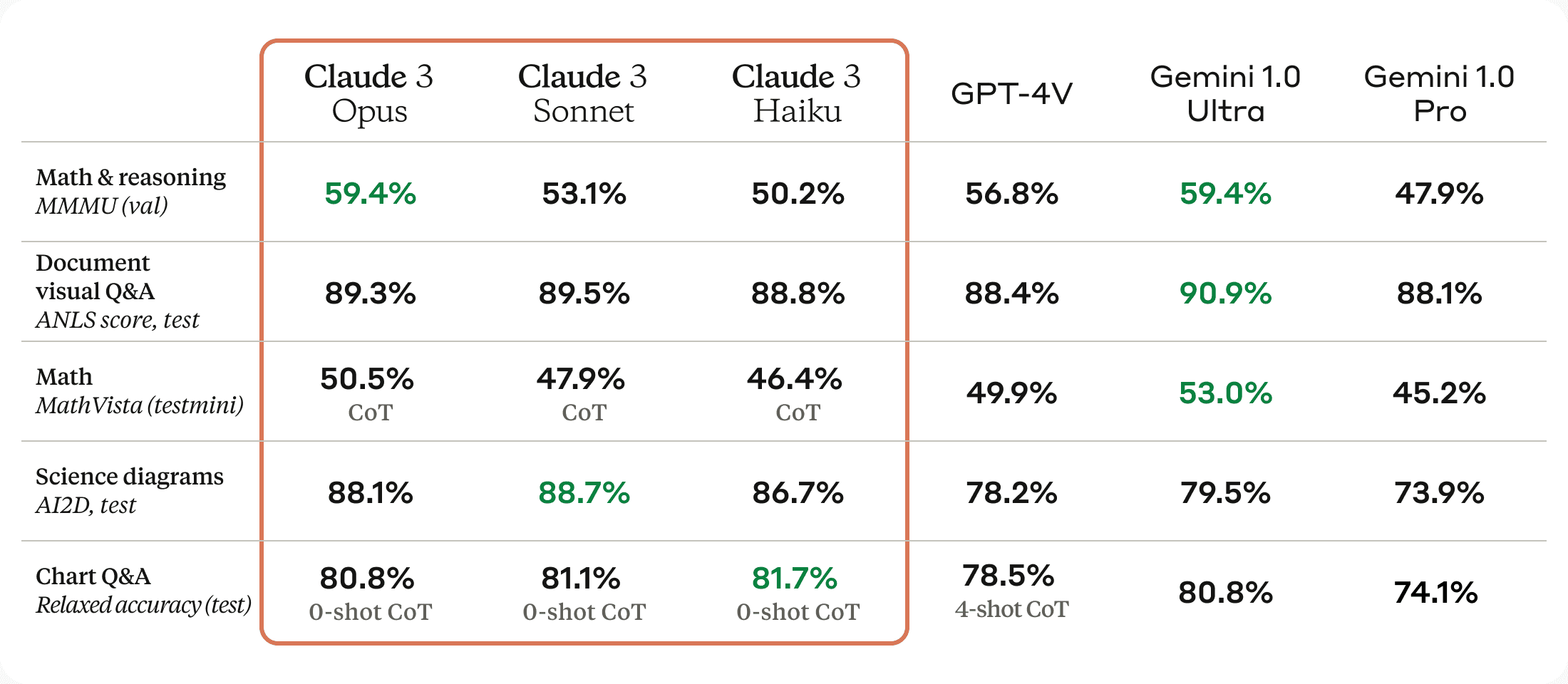Millions of people use chatbots, but a few understand how they actually differ and how to choose a model right for your tasks. As AI and LLMs get better, it is useful to understand the capabilities and nuances of different models. My name is Artem, I am Writingmate founder, and I hope this article of mine will be useful to you. Even if the models are made by the same company and are from the same line-up. That is why in this article, I will dive deep into the differences between Claude 3.5 Sonnet and Claude 3 Opus. Let's explore their strengths, weaknesses, and real-world applications in Claude 3 sonnet vs Opus. I will also highlight a unique tool thatlets you use and compare both of those models. Let's start.
Overview of Claude 3.5 Sonnet and Claude 3 Opus
Claude 3.5 Sonnet and Claude 3 Opus are two advanced AI models developed by Anthropic. Each is serving distinct purposes, and I will try to explain this in the following article. Claude 3.5 Sonnet is now the latest in the series, designed to provide faster and more efficient performance, particularly in tasks requiring complex reasoning and code generation. Claude 3 Opus, on the other hand, focuses on delivering deep analytical capabilities, making it ideal for more intensive tasks like research, strategy, and high-level content creation. Many think that there is Claude 3.5 Opus, but… not yet. So we will compare models that actually exist, Claude3opus and Claude 3.5 sonnet, giving features comparison table with competitors.
Key Differences Between Claude 3.5 Sonnet and Claude 3 Opus
1. Performance and Speed
Claude 3.5 Sonnet operates at twice the speed of Claude 3 Opus, making it a more cost-effective choice for tasks requiring quick turnaround times. This speed is particularly eddicient for businesses needing rapid responses, such as customer support or dynamic content generation. However, while Claude Opus 3 may be slower, it offers a higher level of depth and intelligence. I would say it makes it more suitable for complex analytical tasks.
Here is that benchmark by Anthropic that I promised to give:

2. Task Suitability
Claude 3 Opus is your go-to model if your project requires nuanced content creation. It's known for solving some intricate tasks, like generating detailed research reports, or f.e. analyzing complex data, and creating high-quality content that demands a deeper understanding. Claude 3.5 Sonnet, while slightly less capable in these areas, excels in multi-step workflows and is particularly effective for orchestrating tasks that require fast processing and context-sensitive responses. In brief, that is probably the main difference between the two.

3. Vision Capabilities
Claude 3.5 Sonnet also outperforms Opus in vision tasks, such as interpreting charts, graphs, and other visual data. This makes Sonnet a better choice for industries where visual information is critical. For example: retail, logistics,. financial services and more. Its ability to accurately transcribe text from imperfect images adds another layer of utility. Where is it useful? I would say, in environments where data is often presented in non-standard formats.
More about Vision capabilities: https://docs.anthropic.com/en/docs/build-with-claude/vision

4. Coding Proficiency
Both models are proficient in coding, but Claude 3.5 Sonnet shows a marked improvement in complex coding tasks. In those internal evaluations, Sonnet solved 64% of coding problems, so it outperformed Opus a lot. Remember, Claude Opus solved just 38%, a weak result in my opinion. This makes Sonnet particularly useful for developers that are working on updating legacy applications, or migrating codebases.

Real-World Applications
Both Claude 3.5 Sonnet and Claude 3 Opus have been integrated into a lot of industries. Let me coin some of examples:
Customer Support: Claude 3.5 Sonnet's speed and contextual understanding make it ideal for real-time customer support, where quick and accurate responses are crucial. I would say Gemini 2 is still better in this regard but Claude is sufficient enough. Remember, you can try and compare both at Writingmate.
Research and Development: Claude 3 Opus is great when it comes to generating comprehensive research reports and strategic documents. I would say it's awesome for usinesses that need detailed analyses. So, most of businesses :)
Visual Data Interpretation: For companies dealing with visual data, such as financial institutions; for interpreting charts and graphs, Claude 3.5 Sonnet helps a lot with its superior vision capabilities.
In this video, the Nerdy Nvelist explains how those most popular of Anthopic's models compare to each other when writing, but there are also some detailed comparisons for various other neiches. Let me show you some other examples below.
Examples of Real-World Comparisons
And here are more detailed comparisons in various real-world applications and use cases:
Healthcare Documentation: Claude Opus 3 can assist medical professionals by generating detailed patient reports, summarizing medical research, and creating strategic healthcare plans. On the other hand, Claude 3.5 Sonnet could be used in telemedicine to provide quick, accurate responses to patient inquiries, improving the efficiency of virtual consultations.
Content Creation: For a digital marketing agency, Claude 3 Opus can generate high-quality blog posts, whitepapers, and social media content that requires in-depth research and analysis. Meanwhile, Claude 3.5 Sonnet could be used to create more immediate content, like what GPT often does. For example, some short-form social media posts, ad copy, or quick-turnaround blog entries. Analysis = Opus; Creation = Sonnet, as easy as that.
Legal Industry: Lawyers could use Claude 3 Opus to draft comprehensive legal documents, analyze case law, and prepare detailed briefs. Remember to check with actual law and ask that chatbot for correct sources, or you can get into trouble! What about Sonnet? It might be more suited to tasks like managing client communications, quickly drafting standard legal forms, or f.e. providing initial case assessments.
Software Development: Claude 3.5 Sonnet's improved coding proficiency makes it ideal for software developers who need to write, edit, and troubleshoot code quickly. It can help in debugging a complex piece of code or translating code from one programming language to another. Claude 3 Opus and its analytical "mind", might be better suited to make complex algorithms or develop new software architectures.
Education: In an educational setting, Claude 3 Opus could be used to generate detailed lesson plans, conduct in-depth research on academic topics, and create comprehensive study guides. Claude 3.5 Sonnet could be utilized for grading assignments, providing real-time feedback to students, and generating quizzes or other teaching materials quickly.
So these examples that I given highlight how both recent Claude models can be used across various industries. As you see, each is better in different areas, depending on the complexity and speed required for your task.

Using Claude Models in Writingmate
One of the most exciting developments in AI is the ability to use multiple models within a single platform. Writingmate allows you to access a range of AI models, including both Claude 3.5 Sonnet and Claude 3 Opus, along with GPT-4, Mistral, LLaMA, and more. This flexibility means you can choose the best model for each specific task, compare their outputs side by side, and probably even combine their strengths to achieve optimal results.
In Writingmate, you can also generate images, making it a comprehensive tool for content creation, research, and development. This platform is designed to be user-friendly, with a focus on enhancing productivity and creativity across various applications.
Try Writingmate for free here: https://writingmate.ai
Conclusion
Choosing between Claude 3.5 Sonnet and Claude 3 Opus depends largely on your needs. If speed and efficiency are your top priorities, especially for tasks involving customer interaction or quick content generation, Claude 3.5 Sonnet is the better choice. However, if your work requires deep analysis, detailed research, or high-quality content creation, Claude 3 Opus offers the advanced capabilities you need.
With platforms like Writingmate, you can use the power of both models, compare them directly, and use them alongside other top AI models. That enhanced my work and will make yours better as well. Whether you're developing code, generating content, or analyzing data, a Claude model (in my opinion and experience) suits your needs very well.
For detailed articles on AI, visit our blog that we make with a love of technology, people, and their needs.
Written by
Artem Vysotsky
Ex-Staff Engineer at Meta. Building the technical foundation to make AI accessible to everyone.
Reviewed by
Sergey Vysotsky
Ex-Chief Editor / PM at Mosaic. Passionate about making AI accessible and affordable for everyone.



